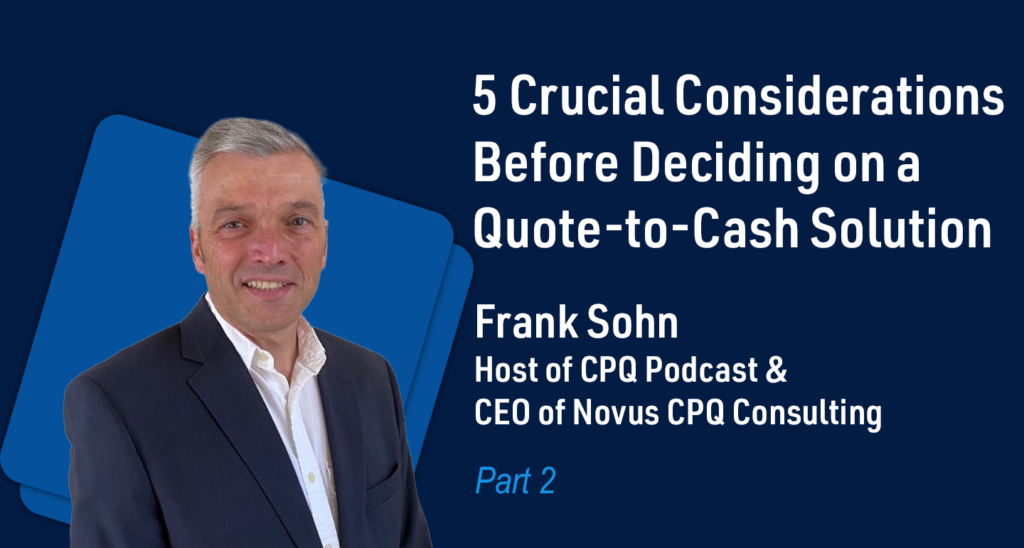5 Crucial Considerations Before Deciding on a Quote-to-Cash Solution, Pt. 2
In my previous post, we explored three key pillars for a successful Configure-Price-Quote (CPQ) implementation: (1) Cost, (2) Industry Suitability, and (3) Seamless Integration. Now, let’s dive deeper into the final two pieces of the puzzle: (4) User Acceptance criteria and (5) Ongoing Maintenance considerations.
Companies are motivated to implement a quote-to-cash solution, especially given that it can be a fundamental aspect of closing deals faster (see also my recent post 3 Keys to Closing Deals Faster with CPQ in 2024). But these additional two factors can make or break your CPQ journey. So, let’s pay close attention to these two areas to help ensure a better CPQ project and result.
Crucial Consideration #4: User Acceptance
Even the most powerful CPQ solution is useless if your team refuses to use it. Sure, a user-friendly interface and intuitive features go a long way, but securing user buy-in requires more than just ticking boxes. The key ingredient for a successful CPQ project remains the early and active engagement of your future CPQ users.
From the get-go, invite them to participate in:
- CPQ solution demos: Let them test-drive the system, feel its interface, and experience its capabilities firsthand.
- The selection process: Give them a voice in choosing the solution that best fits their needs and workflows.
- Open feedback sessions: Encourage honest critiques and suggestions. Their concerns (addressed early) can become stepping-stones to successful adoption.
While a complete team consensus isn’t always necessary, it is vital that key players and essential teams are generally on board. Their enthusiasm and commitment will be contagious, propelling the entire project forward. Remember, a successful CPQ implementation isn’t just about technology; it’s about people. By cultivating user acceptance early and often, especially from users with disparate needs, you pave the way for a smooth transition and unlock the full potential of your new CPQ solution.
Crucial Consideration #5: Implementation and Maintenance
Choosing a CPQ solution is just the first step. Then comes the crucial stage of putting it to work. And in this phase, a smooth implementation and manageable maintenance routine are key to long-term success. Let’s dive into two critical aspects. First is who handles the initial setup and support, and second is who takes care of the long-term success.
Who handles initial setup and support?
CPQ implementation requires skilled resources. Most vendors offer professional services, or they partner with system integrators to guide you through the process. While DIY implementation might seem tempting, it’s rarely feasible for complex solutions like CPQs.
The key lies in finding the right balance:
- Self-sufficiency: A user-friendly system empowers your team to handle minor tweaks and updates.
- Expert support: Complex configurations, pricing rules, and integrations likely require professional support and guidance. Remember, CPQs are powerful solutions, and unlocking their full potential often requires specialized knowledge.
- Long-Term Care: Keeping your CPQ running in an operational environment.
Now, let’s talk about the ongoing upkeep and maintenance:
- Product configuration & pricing rules: Ideally, product managers or relevant stakeholders should be able to easily create and manage these rules without needing extensive technical expertise. Look for a solution with a balance of power and user-friendliness, like MS Excel-like formulas for simpler tasks. Note that for more complex rules, scripting or programming languages may be better suited. For these types of rules, support from the IT Team will be required.
- Quoting forms: Different needs require different forms. Ensure flexibility in creating and assigning quoting forms for specific use cases.
- Integration with new systems: As your IT landscape evolves, your CPQ should adapt. Clearly define and negotiate responsibilities for future integrations with new systems – will the vendor, system integrator, or your internal team need to primarily handle them?
Remember:
- Communication is key. Early discussions with your potential vendor and partners will ensure everyone is on the same page about implementation and maintenance responsibilities.
- Plan for the future. Choose a solution that can adapt to changing needs as well as integrate easily and seamlessly with new systems as your business grows.
By investing in a solid implementation and maintenance plan, you can ensure your CPQ solution flourishes for years to come, driving efficiency and boosting your bottom line over the long run.


Leave A Comment